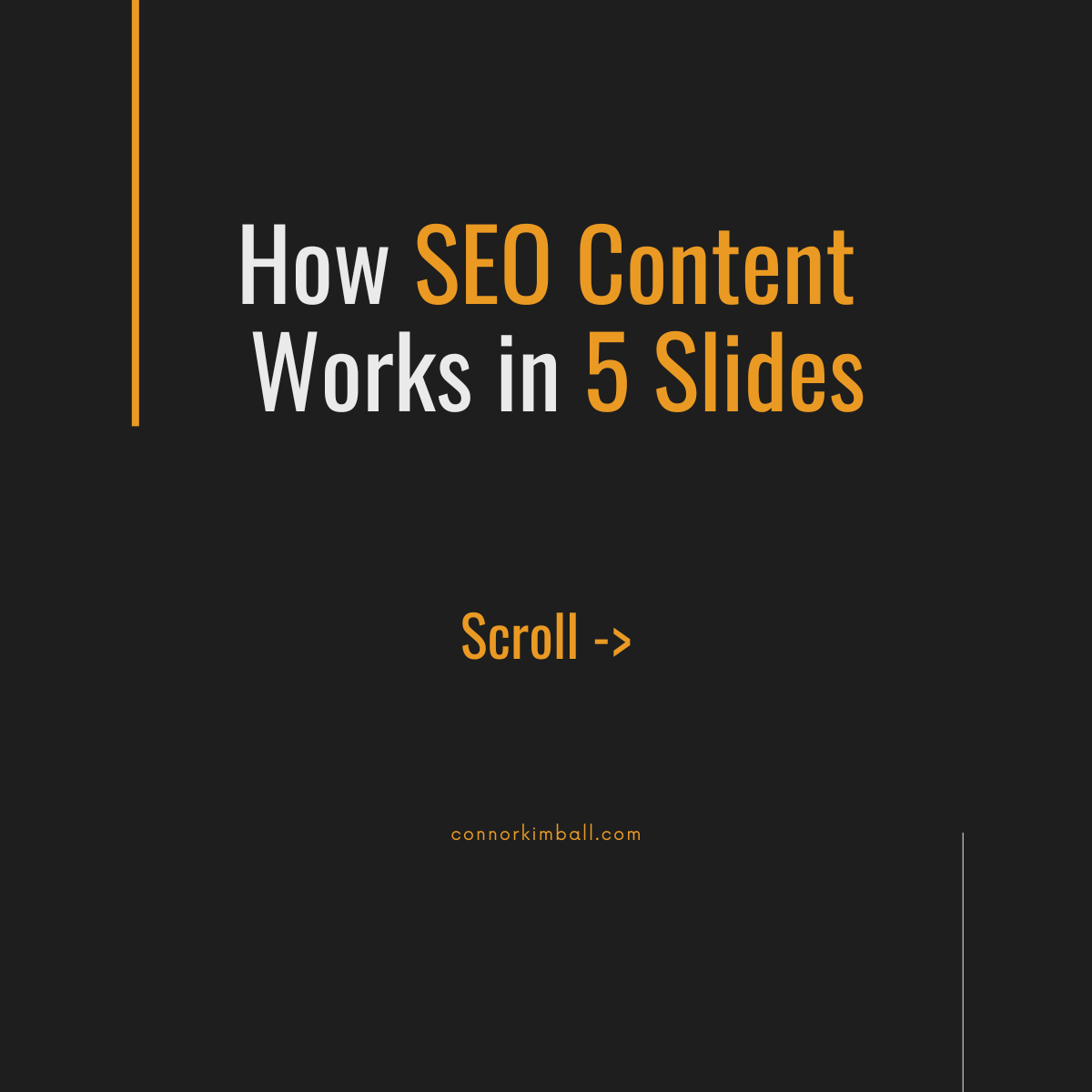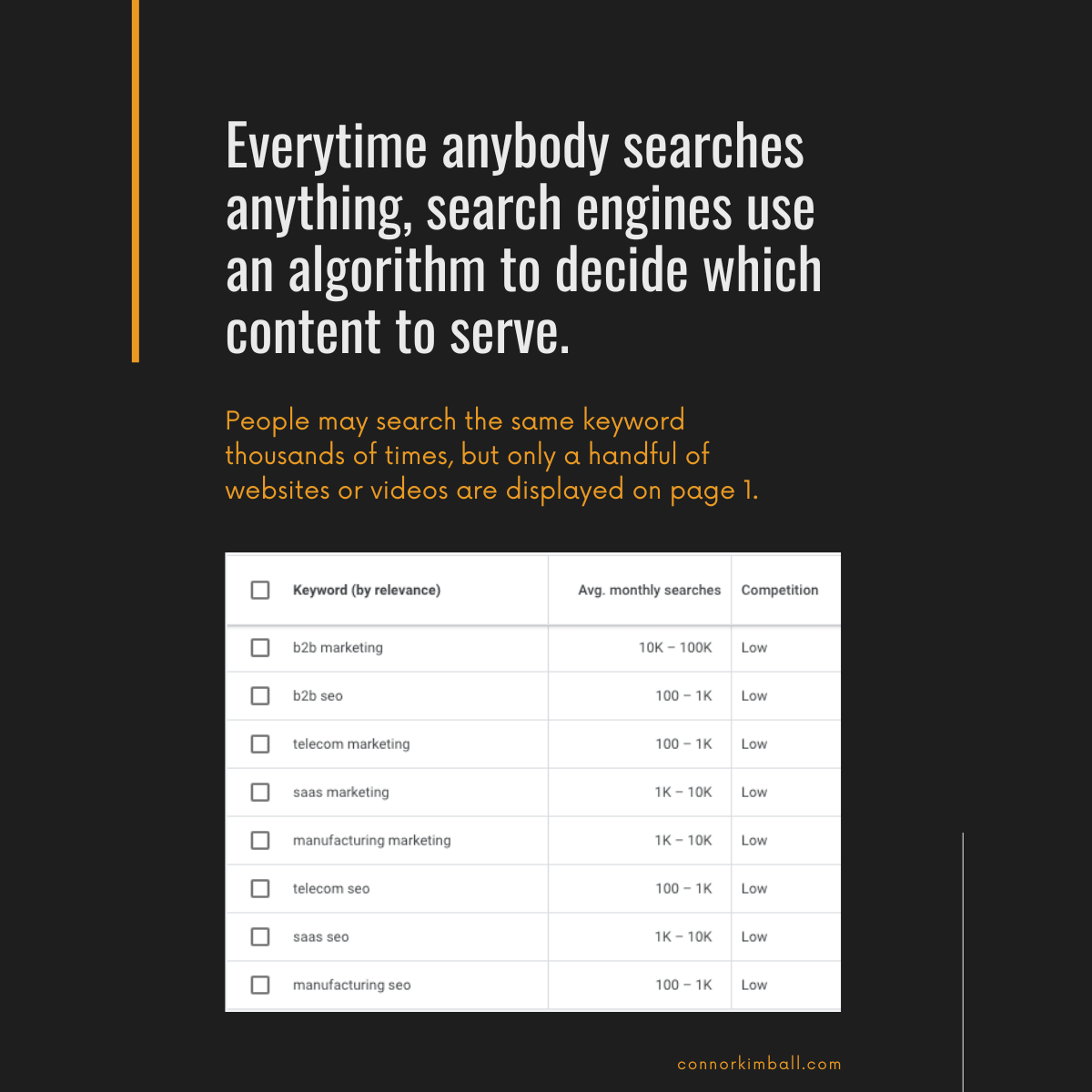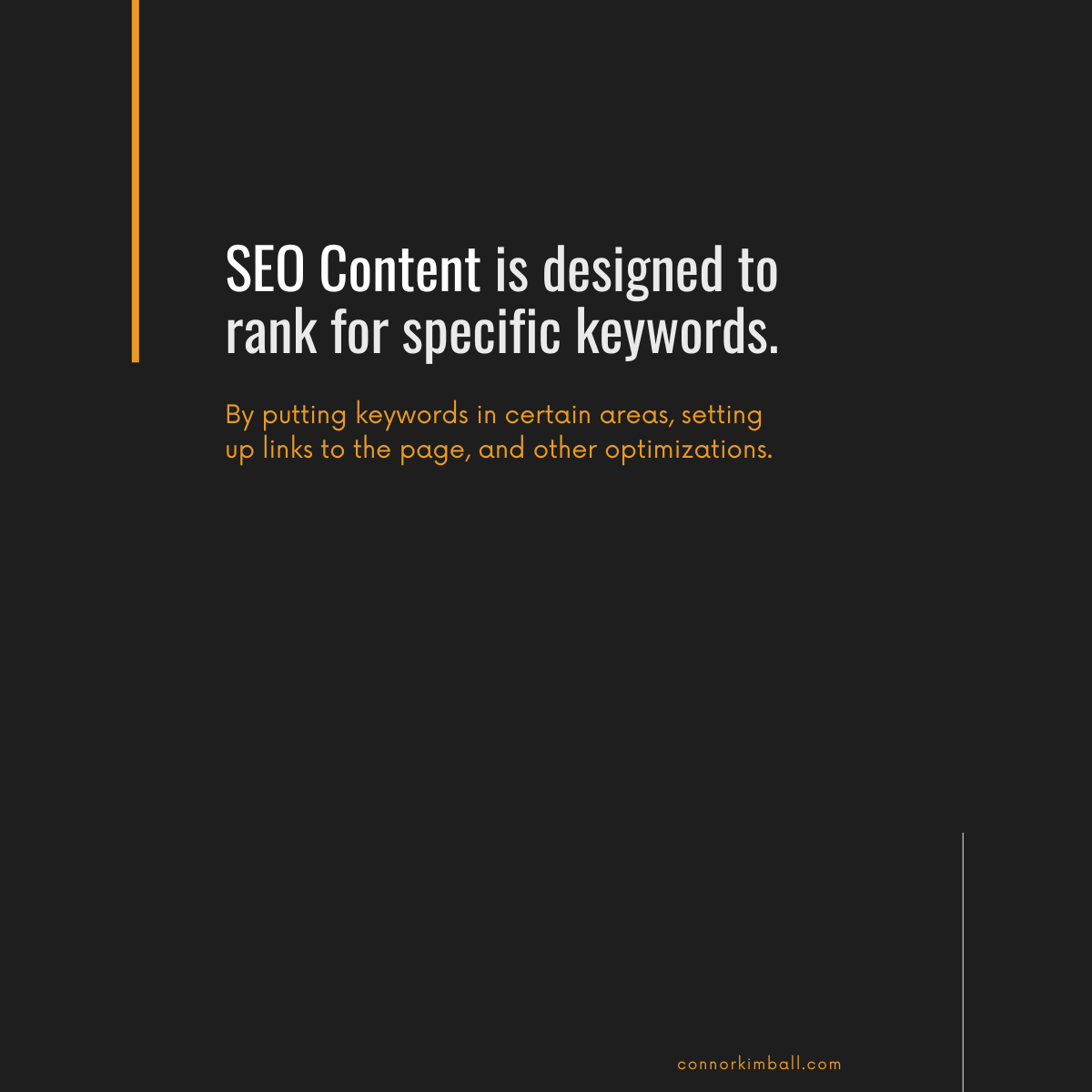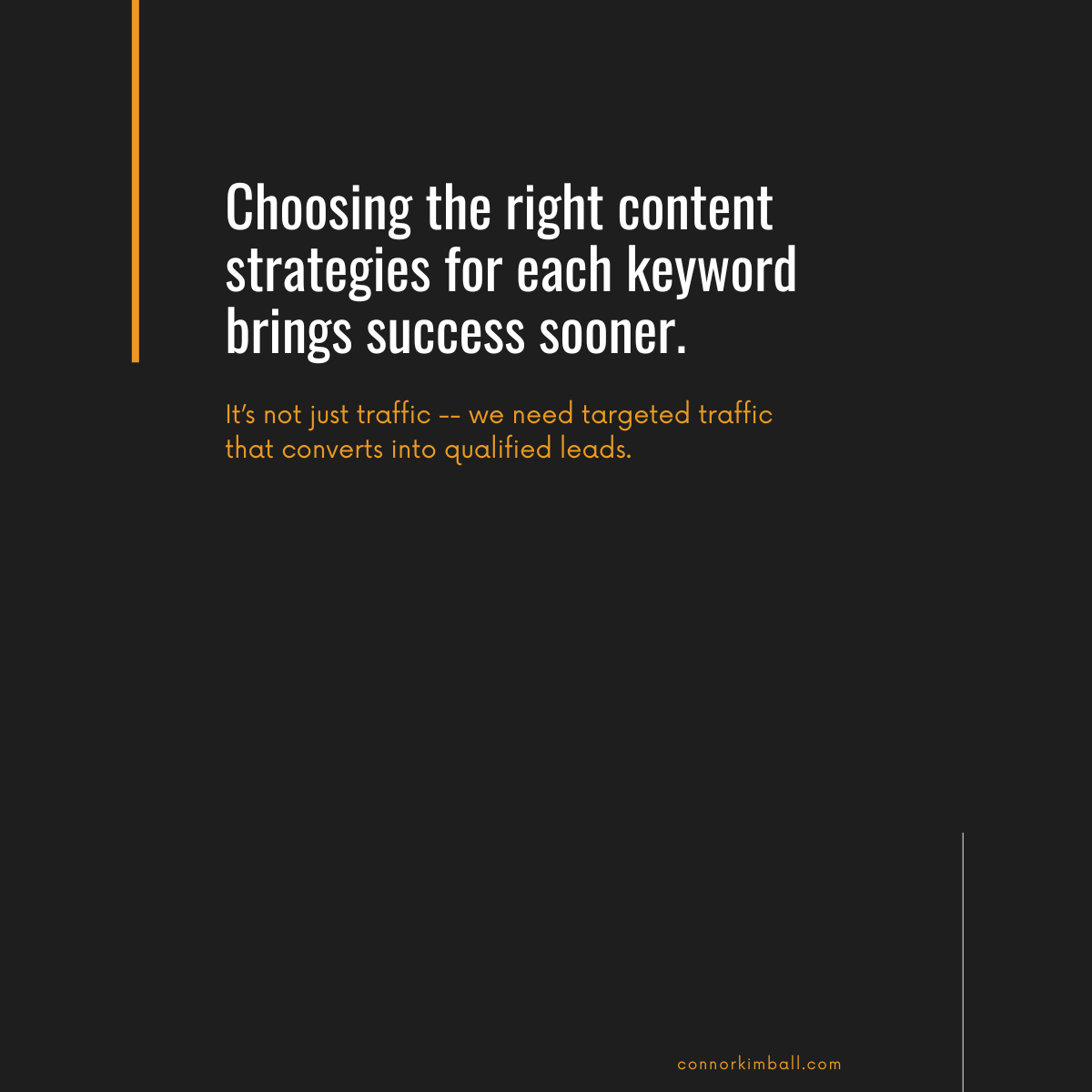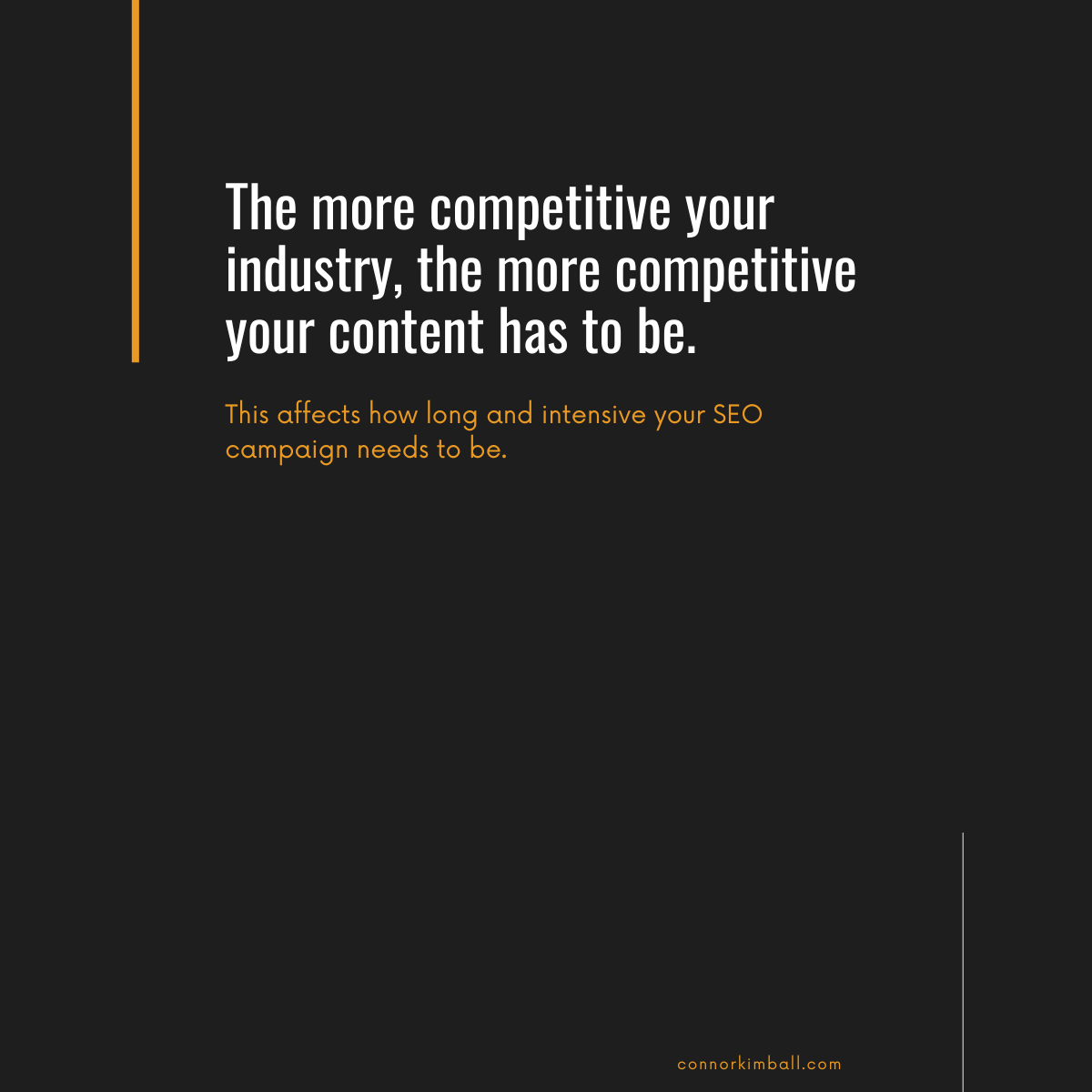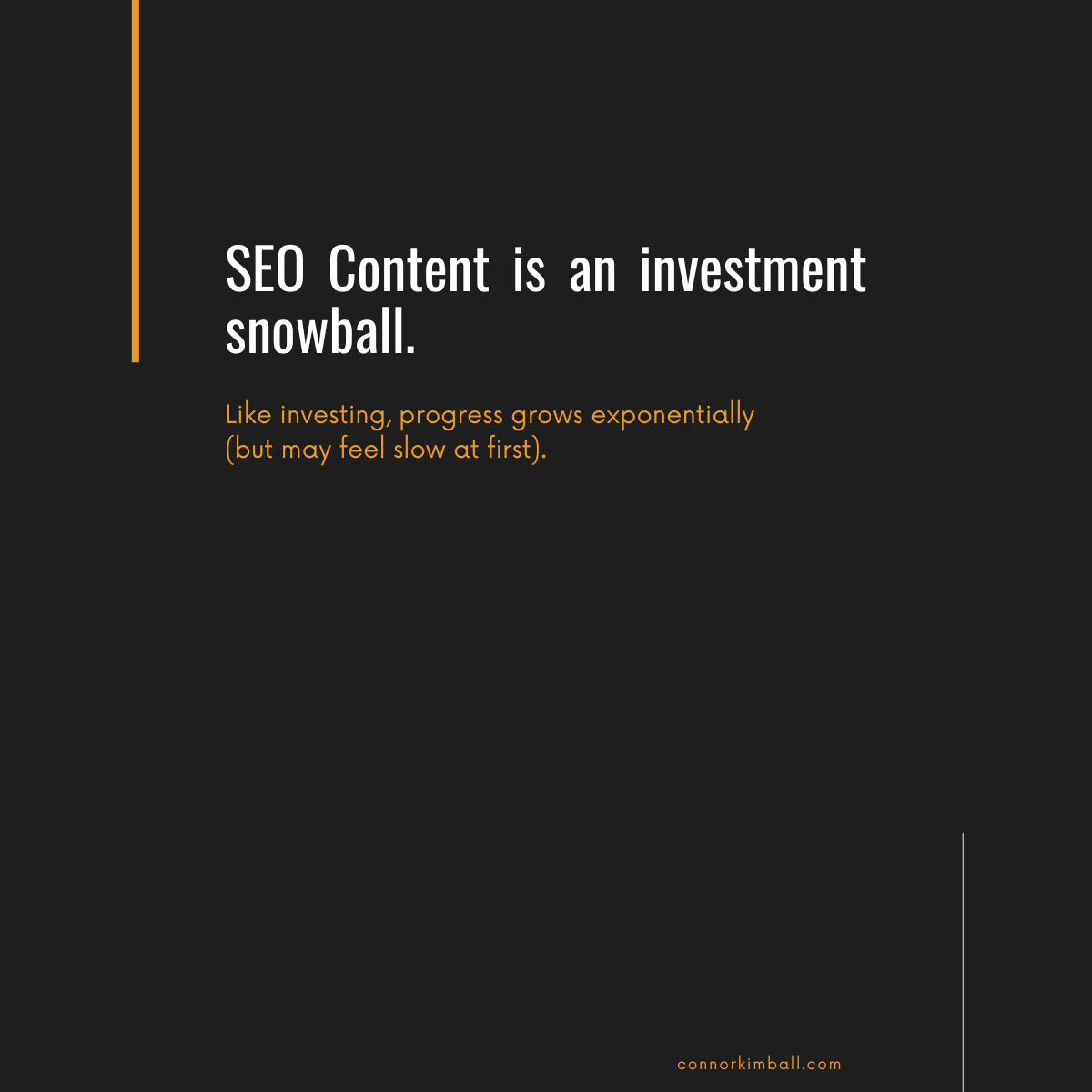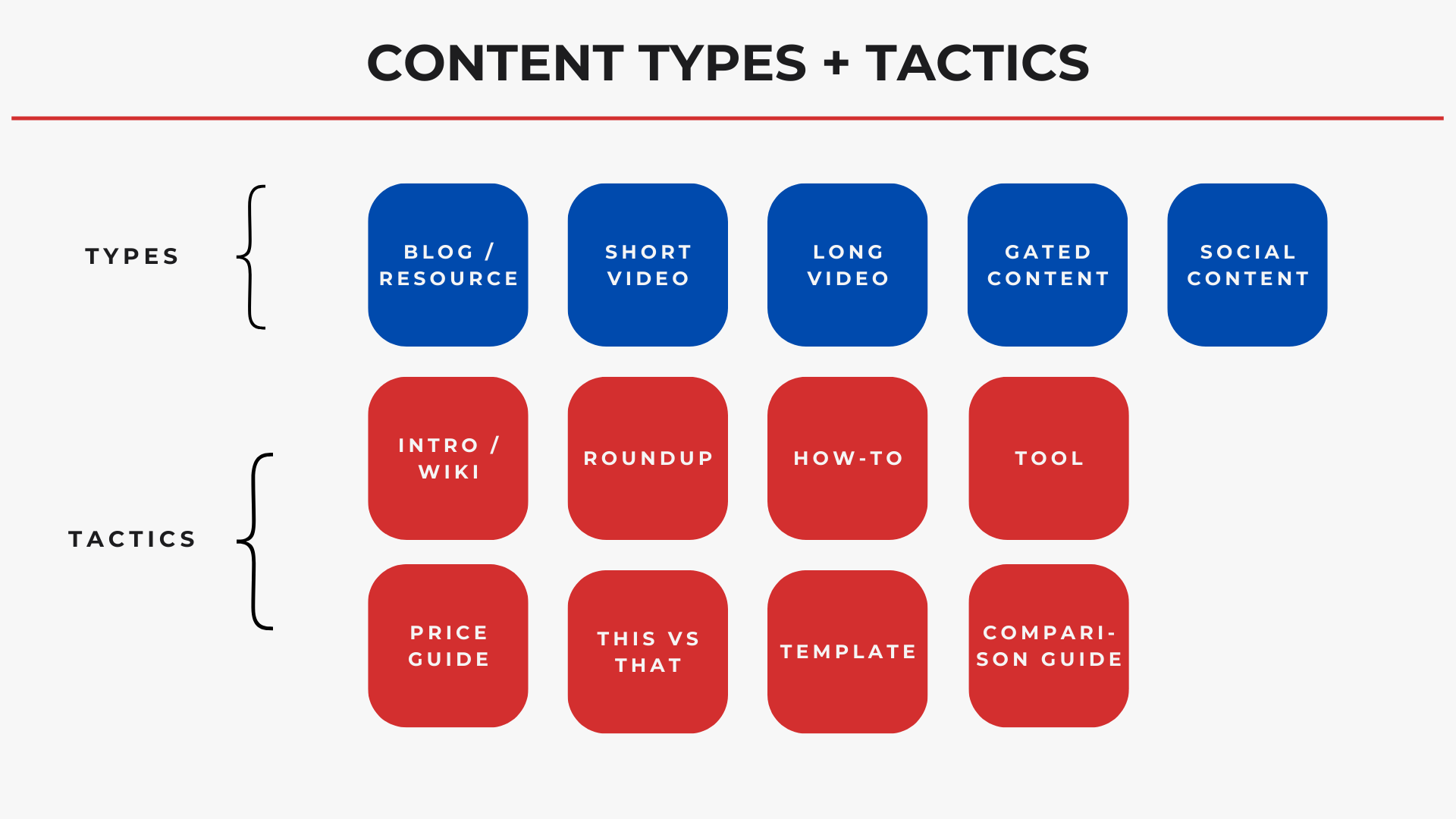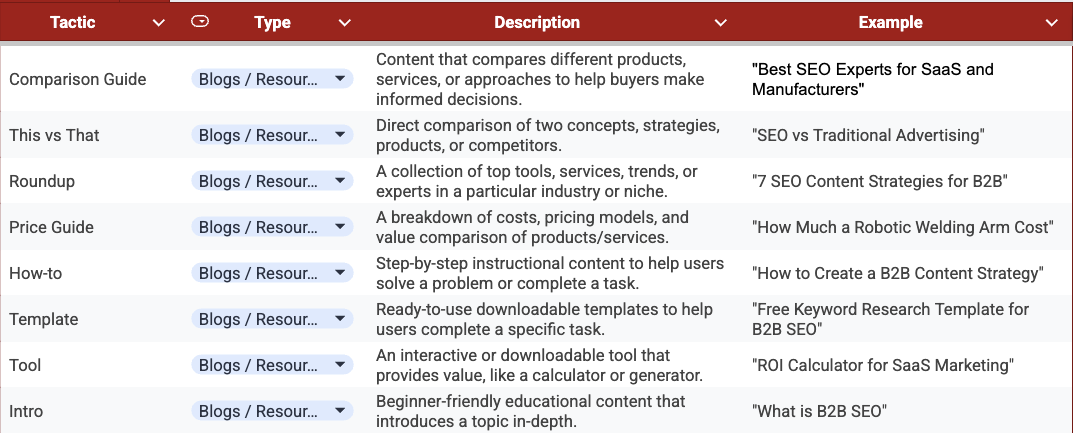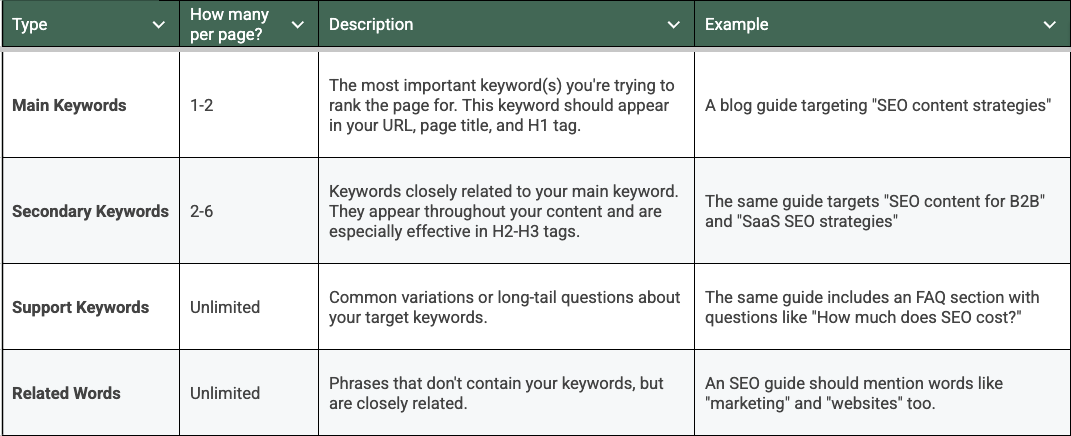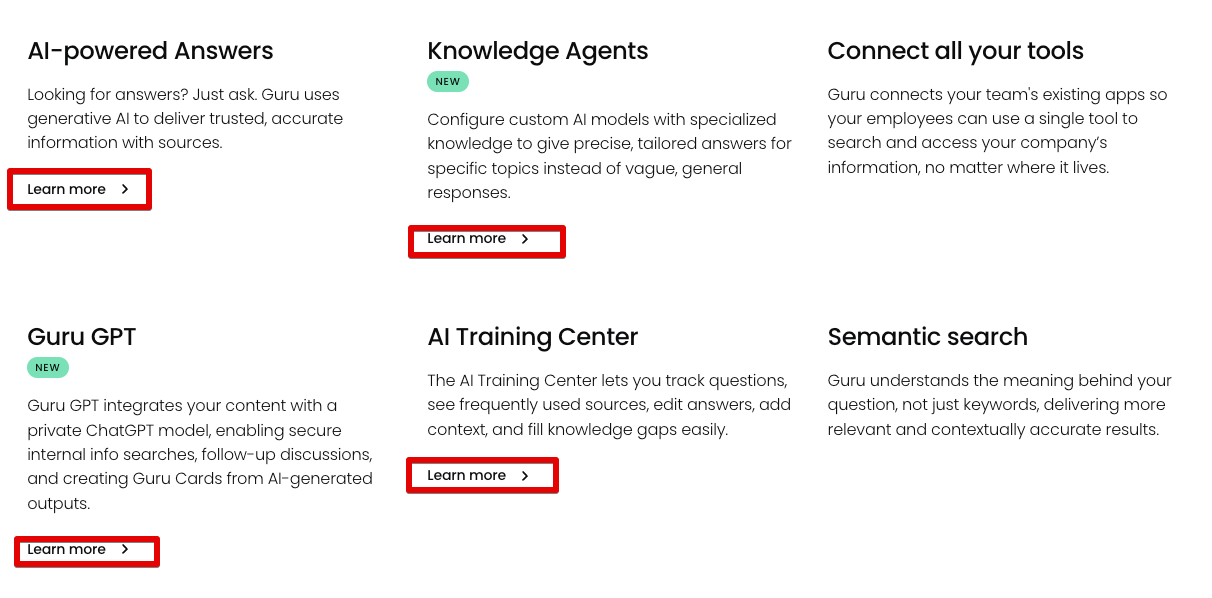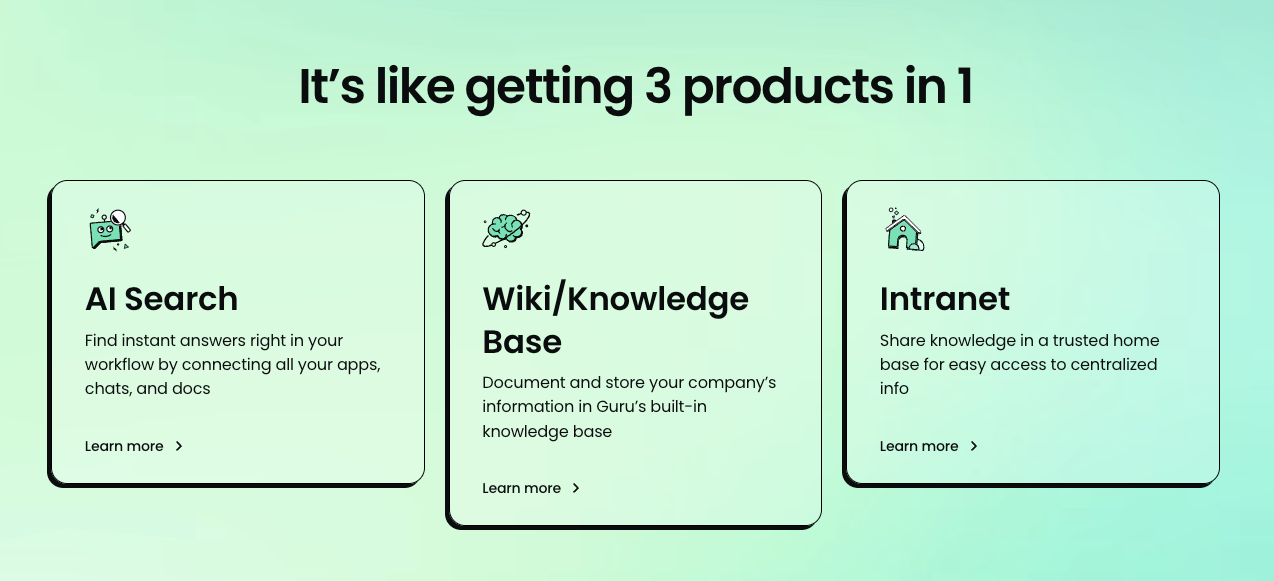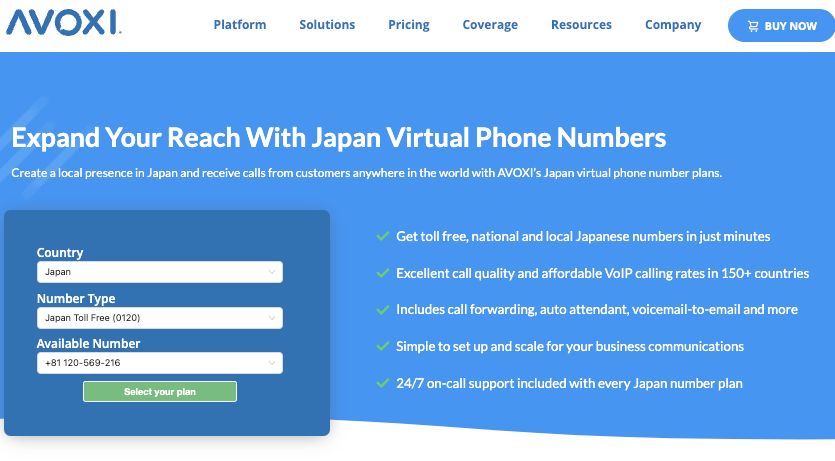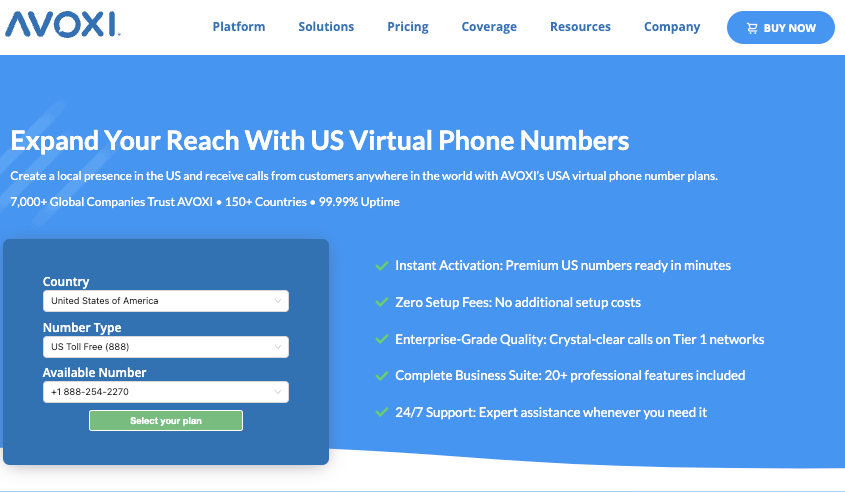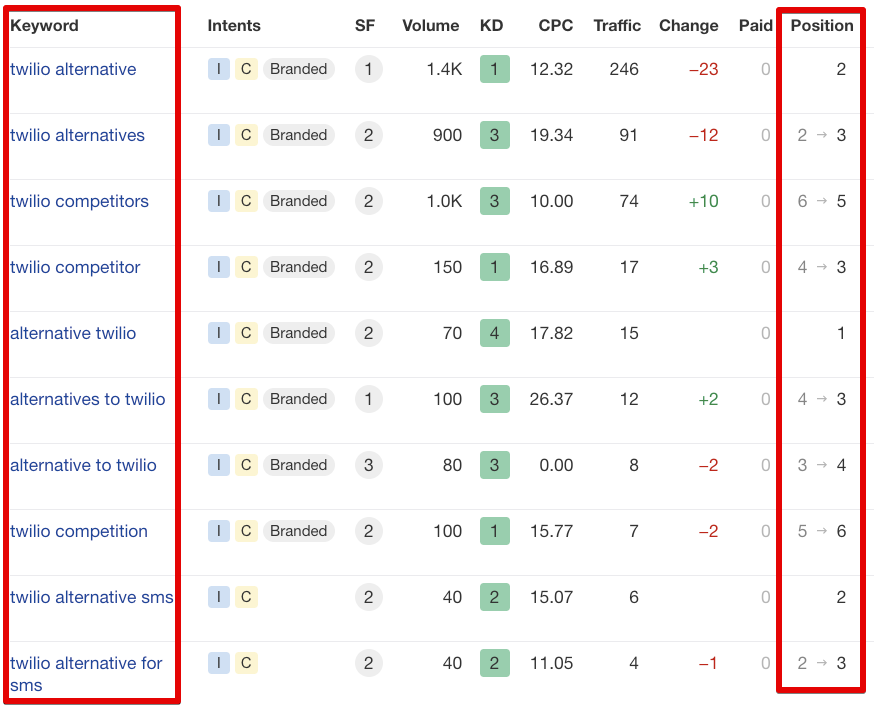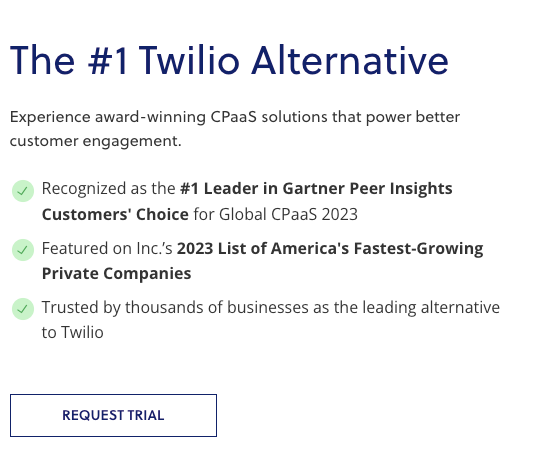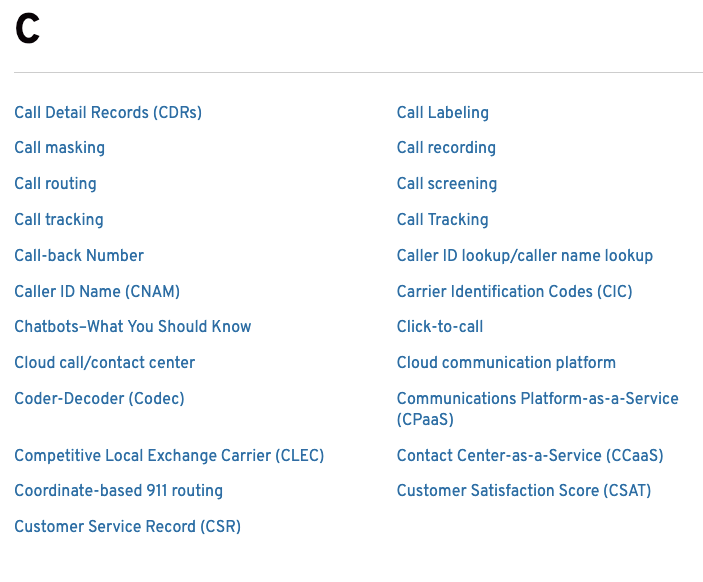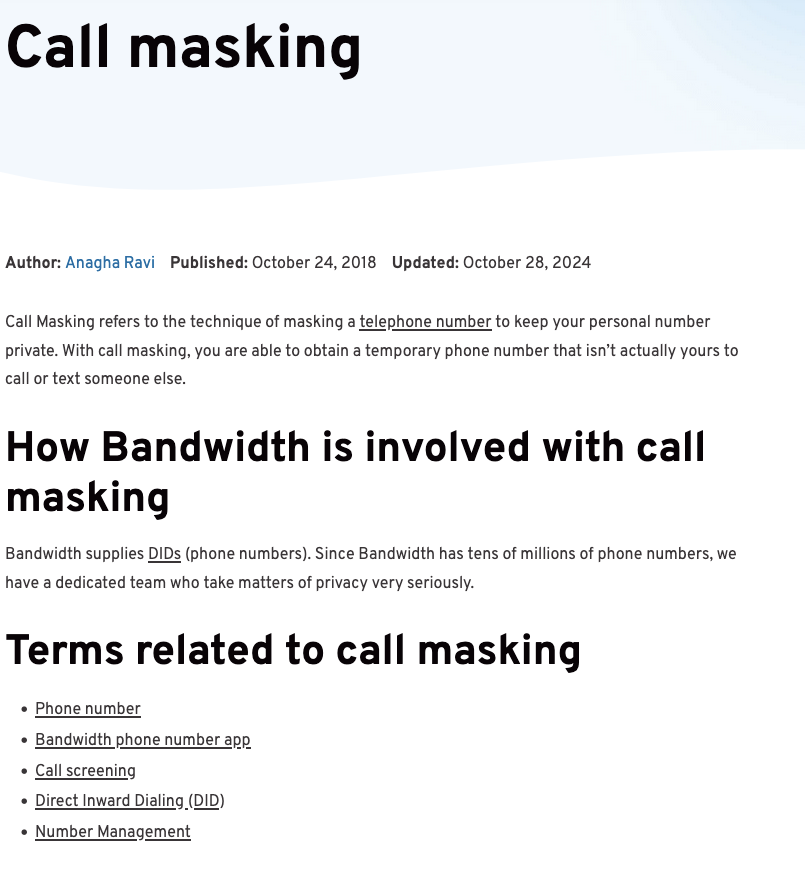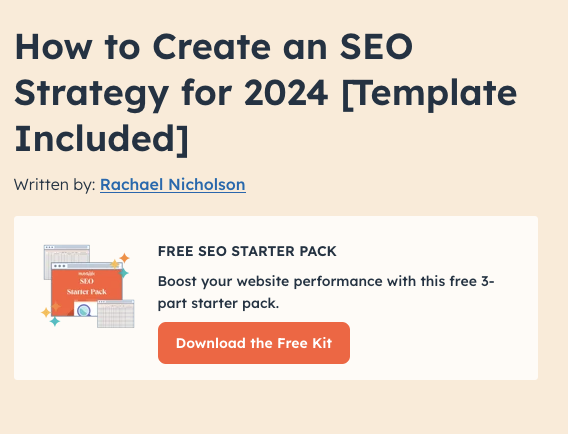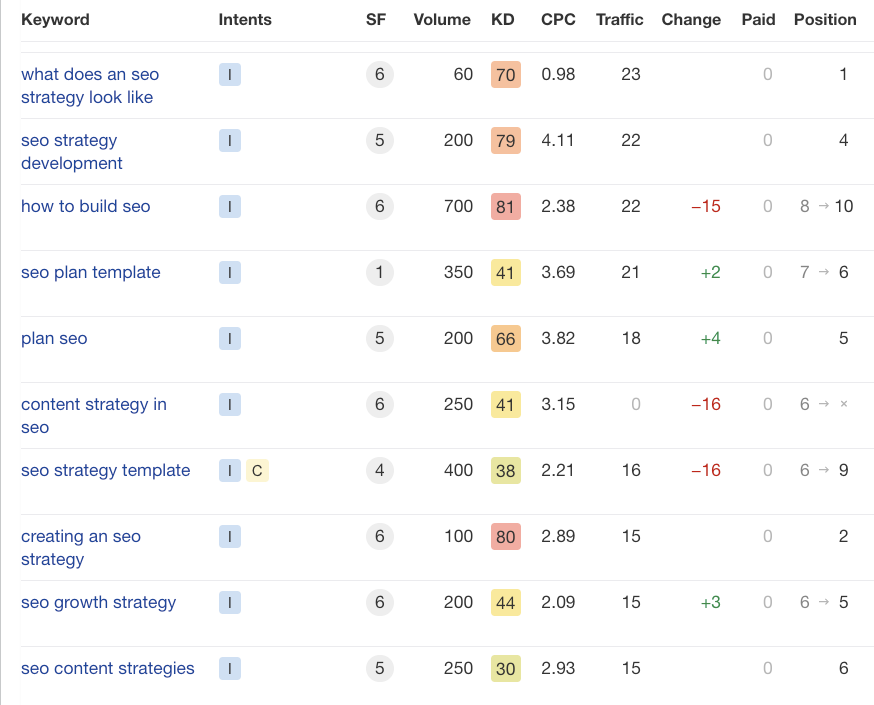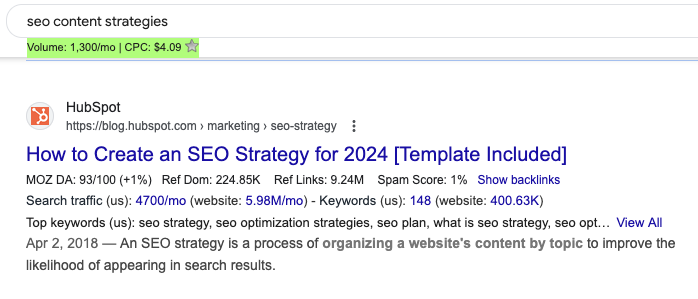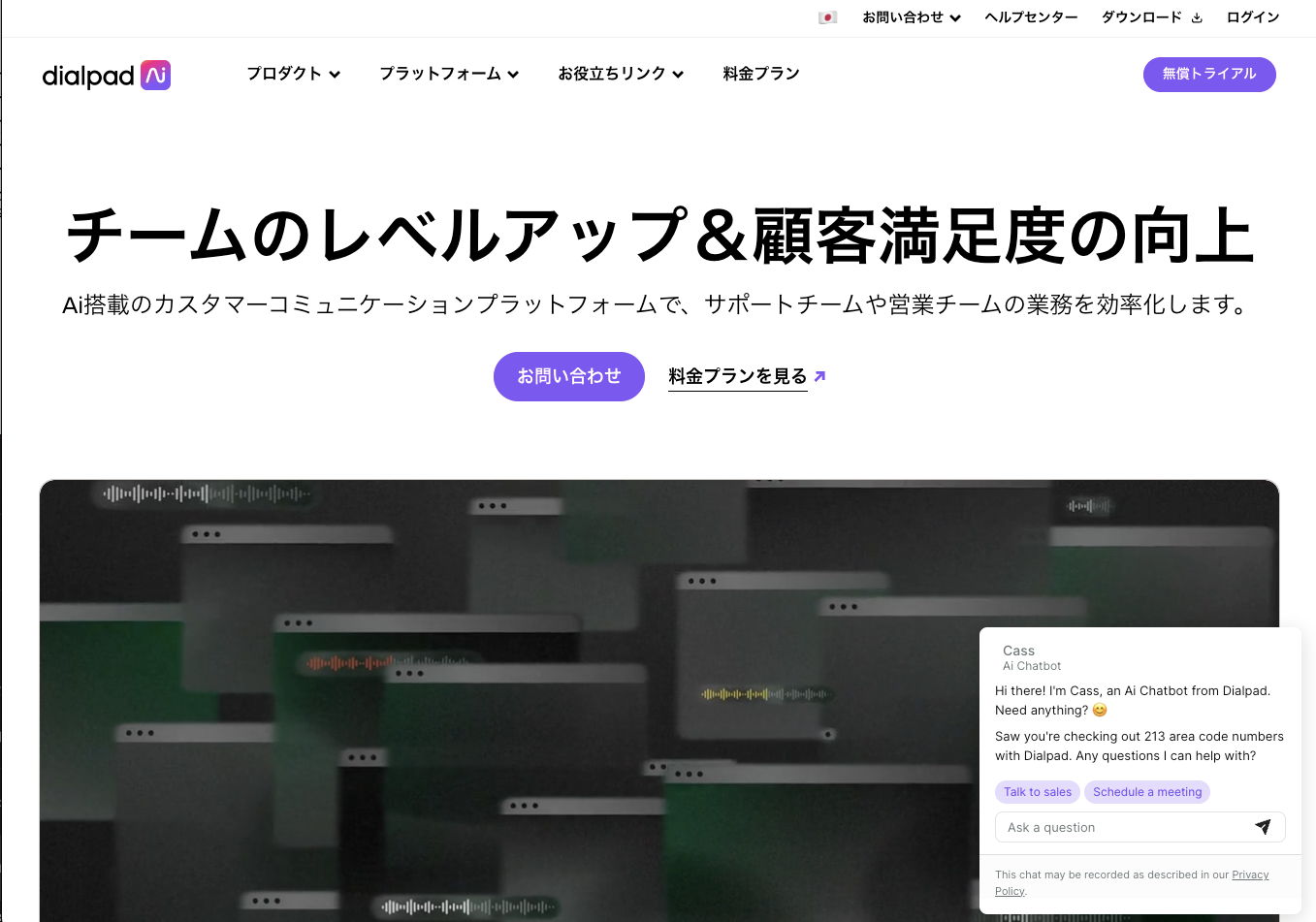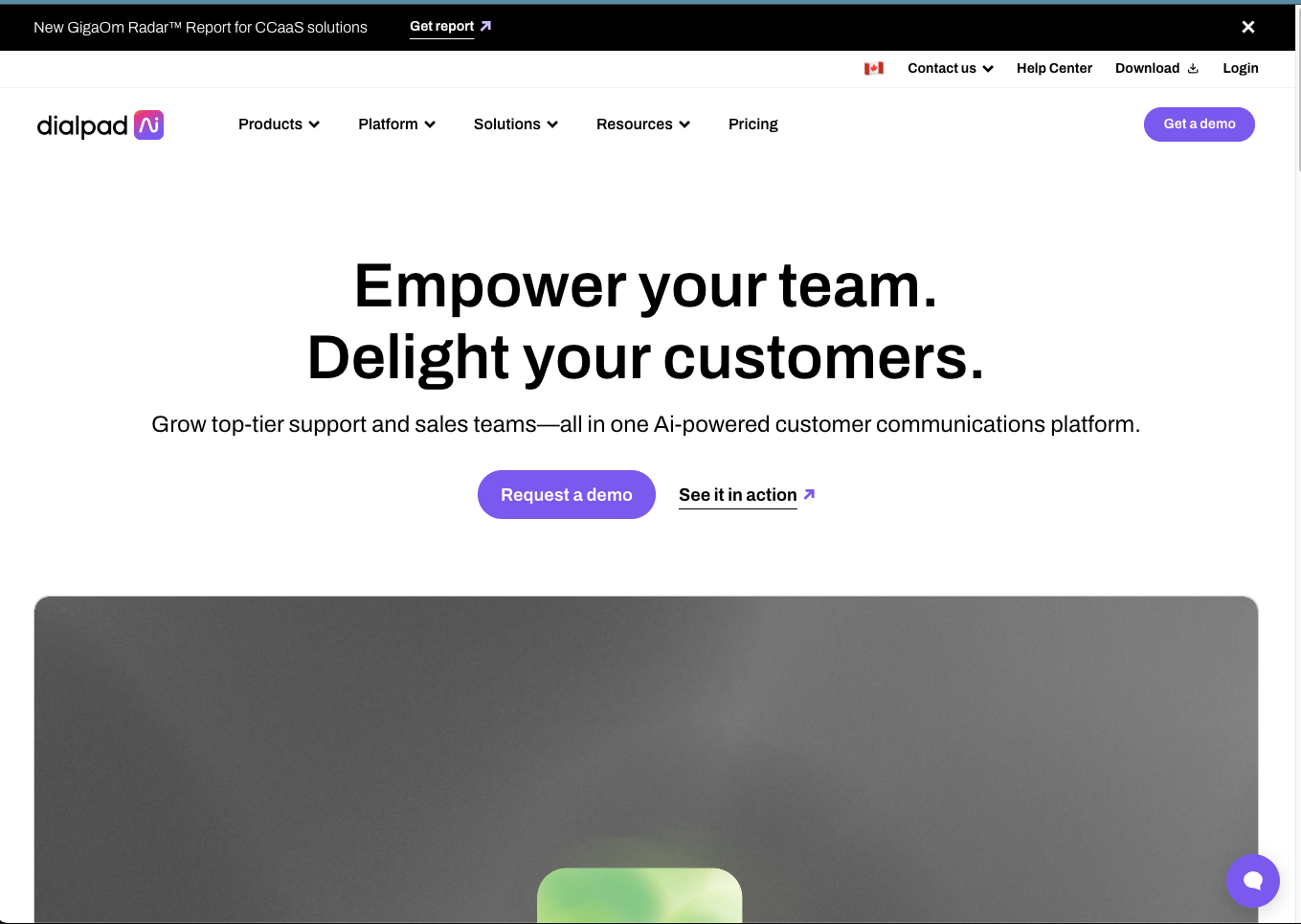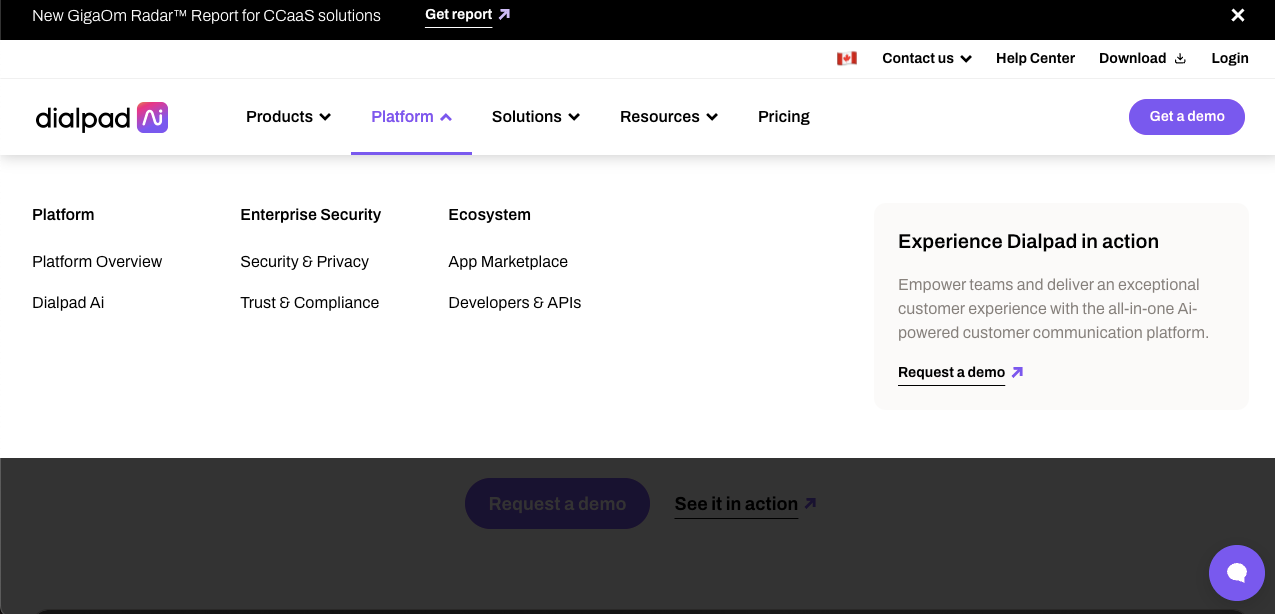There is no AI-generated text here. The SEO strategies, tactics, and tips shared here were acquired through experience and experimentation, and I'm sharing this knowledge with you in my own words. Please enjoy the most useful anecdotes of from my SEO career.
-CK
The basics of "SEO content" are easy to grasp!
Types of SEO Content
These are the types of content that matter for SEO. Most B2B SEO strategies revolve around landing pages and blog / resources, then use video and social content to promote their website.
| Landing Pages | Product / service pages focused on talking potential customers through the buying process and addressing pushback to the sale. You wan |
| Blogs / Resources | Any written piece of content published for free on your website. It could a simple post, expert guide, whitepaper, case study, review, etc. |
| Short Video | A short (under 90 sec) video, generally built around a singular, narrow topic. It could be an interview expert, press video, commercial, gif, explainer video, review, testimonial, or Q&A video. These are generally served best to use as content for social media. |
| Long Video | An in depth video, generally built around a complex subject that requires explaining. It could be an interview, webinar, presentation, training or web series. These videos are great to integrate into blog posts or resource guides, but also play very well when uploaded to YouTube and promoted to your audience (email list especially). |
| Gated Content | A piece of content that requires a form of opt (social share, follow, email) in to receive the item. This could be a template, whitepaper, training, ebook, giveaway, etc. |
| Social Content | This is an “informal” type of content for posting to your targeted social platforms: Linkedin, X, YouTube, TikTok, etc. These can be short or long (but never as long as website content). Incorpating short video and image carousels are effective social content tactics. |
SEO Content Tactics
For each type of content, there are several SEO tactics to choose from. We are focusing on non-landing pages first, with landing page SEO tactics are included at the bottom of this section.
Best content tactics for SEO
These are the most effective SEO tactics to know in 2025.
| Comparison Guide | Blogs / Resources | Content that compares different products, services, or approaches to help buyers make informed decisions. | "Best SEO Experts for SaaS and Manufacturers" |
| This vs That | Blogs / Resources | Direct comparison of two concepts, strategies, products, or competitors. | "SEO vs Traditional Advertising" |
| Roundup | Blogs / Resources | A collection of top tools, services, trends, or experts in a particular industry or niche. | "7 SEO Content Strategies for B2B" |
| Price Guide | Blogs / Resources | A breakdown of costs, pricing models, and value comparison of products/services. | "How Much a Robotic Welding Arm Cost" |
| How-to | Blogs / Resources | Step-by-step instructional content to help users solve a problem or complete a task. | "How to Create a B2B Content Strategy" |
| Template | Blogs / Resources | Ready-to-use downloadable templates to help users complete a specific task. | "Free Keyword Research Template for B2B SEO" |
| Tool | Blogs / Resources | An interactive or downloadable tool that provides value, like a calculator or generator. | "ROI Calculator for SaaS Marketing" |
| Intro | Blogs / Resources | Beginner-friendly educational content that introduces a topic in-depth. | "What is B2B SEO" |
Landing page SEO
Landing page SEO is often more important than conventional content for B2B companies. You should have a dedicated page for each of your products / services, the features included with each, the areas you serve, and common use-cases for your product.
| Product Landers | Landing Page | Product or service specific pages. | "SEO Platform" |
| Features | Landing Page | Pages about the features included with your products / services. | "SEO Content Analyzer" |
| Use-cases | Landing Page | Popular ways people can use your product. Often labeled "Solutions" on B2B websites. | "SEO Software for B2B Companies" |
| Area Served | Landing Page | Location-based pages that target customers in specific regions with localized content OR global traffic looking for services related to a certain location. | "SEO Solutions for China" |
How to Optimize SEO Content with Keywords
Optimizing your SEO content is straightforward. Add keywords to the right places, add related words to the right places, and organize your content in ways that search engines reward.
How many keywords to choose per page?
In my experience, most pages perform best when targeting 1-2 main keywords while also mixing in secondary keyword targets and related phrases throughout the content.
| Main Keywords | 1-2 | The most important keyword(s) you're trying to rank the page for. This keyword should appear in your URL, page title, and H1 tag. | A blog guide targeting "SEO content strategies". |
| Secondary Keywords | 2-6 | Keywords closely related to your main keyword. They appear throughout your content and are especially effective in H2-H3 tags. | The same guide targets "SEO content for B2B" and "SaaS SEO strategies". |
| Support Keywords | Unlimited | Common variations or long-tail questions about your target keywords. | The same guide includes an FAQ section with questions like "How much does SEO cost?" |
| Related Words | Unlimited | Phrases that don't contain your keywords, but are closely related. | An SEO guide should mention words like "marketing" and "websites" too. |
Best places to add keywords on a page
The most important places to add keywords to your content are displayed in the table below.
| URL | HIGHEST | Keywords in the URL is one of the strongest SEO signals. Of all the ranking factors, this is the most difficult to change later. |
| Page title | HIGHEST | The page title / SEO title is easily one of the strongest SEO signals. |
| H1 tags | HIGHEST | The H1 tag is the main heading of the page. It signals to search engines the core topic of the content. Use one H1 per page with a strong keyword presence. |
| H2 tags | HIGHEST | H2 tags structure the content and help search engines understand sections of the page. Including keywords in them enhances readability and SEO. |
| First 100 words | HIGH | Including keywords in paragraph text is always an SEO signal. Including them towards the beginning of the content is especially powerful. |
| Last 100 words | HIGH | Including keywords in paragraph text is always an SEO signal. Including them towards the end of the content is especially powerful. |
| H3 tags | HIGH | H3 tags further break down sections under H2s, making content more scannable and reinforcing keyword relevance for subtopics. |
| Image alt text | HIGH | Alt text helps search engines understand images and improves accessibility. Use descriptive, keyword-rich alt text where appropriate. |
| Meta description | MEDIUM | While not a direct ranking factor, keyword-rich meta descriptions improve click-through rates by making the result more relevant to searchers. |
| H4-H6 tags | MEDIUM | These tags organize deeper sections of content. Keywords here can support semantic search relevance and user navigation. |
| HTML tags | MEDIUM | Keywords in structured data (e.g., schema markup, bold, italics) help search engines better understand content context. |
| Special text tags | MEDIUM | Bold, italics, and other emphasis tags can highlight important keywords and improve user engagement, indirectly boosting SEO. |
You won't want to add the same keywords into every spot every time, of course. But the more areas you include keywords, the more likely you are to rank. If you're trying to update a piece of content that is stuck on page 2 or 3, adding keywords to a few areas you're missing may be enough to get you on page 1.
Free resource: How to use keywords for SEO →
Social Media and Content Marketing for SEO
How to boost your content with external, authoritative signals.
Where to post SEO content
SEO content belongs on your website, but also on your social media. Remixing content and adding it to blog-sharing websites like is an effective way to rank additional pages in Google and boost your own website with links from external sites.
| Your website(s) | Your money content lives on your website. Landing pages, blogs, resources, etc. that serve your website up directly in search engines. | yourdomain.com |
| Your social media | Your social media is where you share brand-building content, as well as short-form content that promotes long-form content. Your social media profiles show up in search engines and link back to your main website, helping it rank better too. | Linkedin, YouTube, X, Tiktok, Facebook, etc. |
| Content-sharing websites | External content-sharing profiles - this is for sharing remixed SEO content that links back to your original content. This helps your brand take up additional spots in the search results. | Linkedin Pulse, Medium, Reddit, Quora, Spiceworks, Techstack, Hackernoon, etc. |
Social Media SEO
Social media serves many purposes for a brand, but since we're focusing on the SEO implications of social media, I'll keep our attention there.
The SEO benefits of social media content are:
- Social profiles link back to your website. This is a positive ranking signal for your website.
- Social content sends traffic to your website. If you're sending traffic to a page yourself, Google and other search engines are more likely to give you a try.
- Social content can also rank in search engines. It's normal for Google and Bing to rank content from Linkedin, X, Reddit, and YouTube in search results.
Best social media for SEO content
Which platforms you should focus your content-publishing efforts depend on your niche. These are the most relevant platforms for most companies to consider:
| 1B registered users, 300M MAU | Professionals, job seekers, B2B marketers, recruiters | Professional networking, thought leadership, industry news, career tips | No, most links are nofollow | Medium | |
| X / Twitter | 550M MAU | Journalists, politicians, tech enthusiasts, general public | Short-form posts, real-time news, debates, viral trends | No, most links are nofollow | Low |
| YouTube | 2.5B MAU | Global, all age groups, strong Gen Z & Millennial presence | Long-form & short-form video content, tutorials, entertainment | No, most links are nofollow | Medium |
| TikTok | 1.6B MAU | Younger audience (Gen Z, Millennials), creators, influencers | Short-form video content, viral trends, challenges, entertainment | No, most links are nofollow | Low |
| 3B MAU | Broad demographic, skewing older (30+), global | Personal updates, community groups, memes, news, marketplace | No, most links are nofollow | Low-Medium |
Best content-sharing platforms for SEO
This is where I'm posting remixed versions of articles or participating in discussion forums. The goal is always to be helpful to the users of that platform and tactfully share links to your website content as appropriate.
| 430M MAU | Primarily young adults. This is a tech-savvy, global audience. | User-generated discussions, memes, AMAs, deep-dive threads | Yes, but only after gaining karma | High | |
| Quora | 300M MAU | Professionals and knowledge seekers around the world. Wide range of ages. | Q&A-based content, expert opinions, long-form answers | No | Medium-high |
| Hacker News | 3-5M MAU | Developers, tech entrepreneurs, and investors. | Tech news, startup discussions, deep tech insights | No | Low-Medium |
| Stack Overflow | 100M MAU (visitors) | Developers, engineers, IT professionals. Another great place for B2B companies to monitor. | Programming Q&A, code troubleshooting, best practices | No | Medium |
| Dev.to | 1M registered users | Software developers and tech bloggers. Great B2B and B2C content hub. | Developer blogs, coding tutorials, community discussions | Yes, allows dofollow links in articles | High |
| Spiceworks | 2M IT professionals | IT admins, sysadmins, and enterprise IT workers post here. | IT troubleshooting, enterprise tech discussions, product reviews | Yes, allows dofollow links in discussions | High |
| Mastodon | 10M registered users | Privacy-conscious users, tech communities, and activists around the world. | Decentralized social networking, microblogging, niche interest groups | No | Low |
International SEO content
As you can imagine, the list of "best platforms for SEO content" will change if you live overseas or have a multilingual audience. I made list of content-sharing platforms for global SEO here.
Do you need to build links to your content?
Once your website is established and ranks dozens of pages, internal links may be all you need for new content to get placed on page 1. But if your content is well-optimized and you still aren't ranking, your website may lack the backlinks needed to compete on page 1.
Even if you are a new company, most B2B companies do not need expensive link building campaigns for SEO. Here's the most cost-effective way to build your first set of links so search engines recognize you as authoritative:
- Set up your social media profiles manually, make sure they all include links to your website.
- Pay a citation service for 100 - 200 citations ($1 per citation).
- Buy two SEO press releases with 700 words, include anchor text links to your website ($700 per release).
- Consider acquiring 5 - 20 links via sponsored content on sites that Google is rewarding with traffic.
Examples of SEO Content Strategies
Six real-life examples of B2B SEO strategies.
Product page buildout
- Type: Landing page SEO
- Example: Guru (B2B SaaS)
- Description: Guru has an extensive landing page SEO strategy. They built out landing pages for each of its product categories, every popular feature in their platform, and the most popular use-cases for their platform. This leads to several pages that rank for keywords searched by people right before they buy a product like Guru. Every B2B company should follow this landing page SEO strategy before diving too deep into content.
Area served pages (Geographic SEO)
- Type: Landing page SEO
- Example: AVOXI (B2B SaaS)
- Description: AVOXI is a global B2B telco company. They sell phone numbers from practiically every country in the world, so they built a page for each country they serve. If somebody searches for a business phone number keyword plus the name of a country or city, they will likely find AVOXI.
Competitor comparisons
- Type: SEO content
- Example: Plivo (B2B SaaS)
- Description: Plivo's top competitor in the space is Twilio, so they created a page that compares Twilio to its alternatives, including itself. This page ranks for bottom-funnel keywords like "twilio alternatives" and "competitors to Twilio". This is, without a doubt, of the most valuable SEO pages on Plivo's website.
Wiki / glossary content
- Type: SEO content
- Example: Bandwidth (B2B Company)
- Description: Bandwidth created a large glossary of telecom terms. Each page explains the term, how that term relates to Bandwidth and its services, and then links to related glossary content. This SEO strategy is excellent for top-funnel traffic and organic link building.
Templates
- Type: SEO content
- Example: Hubspot (B2B SaaS Company)
- Description: Hubspot might as well be a library of SEO strategy examples. One of the many tactics they use well is template content. Hubspot creates guides and templates that help its target customer accomplish their tasks, earning them respect and loyalty within their niche. This content is normally considered "mid-funnel."
Multilingual SEO
- Type: Landing page SEO or content
- Example: DialPad (B2B SaaS)
- Description: DialPad serves customers around the world and in many languages, which is reflected in their SEO strategy. The example below shows the same product landing page, but in three different languages. This is so powerful because you can multiple SEO content - a page that ranks in English will likely rank in Spanish, German, and other language with proper translation.
Checklist for SEO Content
Run through this SEO checklist before publishing content.
1. Clear keyword targets are assigned to the page.
I like 1-2 main keywords and 2-6 secondary keyword targets.
2. Title tag, URL, H1 tag, and at least one H2 tag contain your primary keyword(s).
These are your most important areas for SEO keywords, but don't neglect the other areas mentioned in the first section (including body text).
3. Your content uses a variety of secondary and supporting keywords throughout.
These are your most important areas for SEO keywords, but don't neglect the other areas mentioned in the first section (including body text).
4. Your content is at least as long as Google’s page 1 average.
You should always be a little longer than the average result. I like publishing content that's 25-50% longer than the average.
5. Images are used with alt text.
Images add a lot of life to content, but are also an SEO ranking factor. Be sure to use keywords in your filenames and alt text.
6. Your content uses bulleted lists, tables, and/or FAQ boxes to display information.
Just like images, these tactics are good for user experience and tend to be rewarded by Google's algorithm.
7. You link to your content from other pages.
You need internal links, preferably with keywords in the anchor text, pointing to the new page you just published.
8. Your content includes at least one link to another piece of content and a landing page.
This is a positive ranking signal for your new page, as well as a boost to the pages you link to. Use a keyword in your anchor text.
9. Submit your URL for indexing.
Once you're published, submit your new URL for indexing in Google Search Console. If you use Rankmath, their instant indexing feature is even faster.
SEO Content FAQs
Your content needs to be long enough to be compete with the pages already ranking on page 1 for your keyword. The more competitive the keywords, the more detailed the content will need to be.
My strategy involves finding the average word count of pages ranking on page 1 for my main keyword. I usually make my content longer than the average by at least 25%. If the average page length for a keyword is 2,000 words, I want my content to be at least 2,500 words.
Just want a general rule to follow? Assume every landing page is 1,200 words and every blog is 2,000 words, minimum. You can expand the content later if your first try is too short to rank.
With so many content types and tactics to choose from, prioritization is essential for an SEO strategy. Here's a good way for SEO experts to prioritize B2B content:
- Landing pages. Every product, service, and feature you sell deserves a landing page. This includes use-cases, like what and how your product is in various situations.
- Bottom-funnel content. Competitor comparisons, price guides, and roundups are the tactics best suited for bottom-funnel traffic that's ready to buy your product.
- Top and mid-funnel content. Intro guides, templates, how-to articles, and tools are the most effective SEO tactics for users that are learning about the problems your solutions solve.
If you already have an established site with significant traffic, SEO updates will affect your rankings in a matter of weeks. If your website is brand new, it can take 3-9 months to start ranking for competitive search terms. In these cases, you can fast forward progress by investing in PR campaigns and sponsored content.

